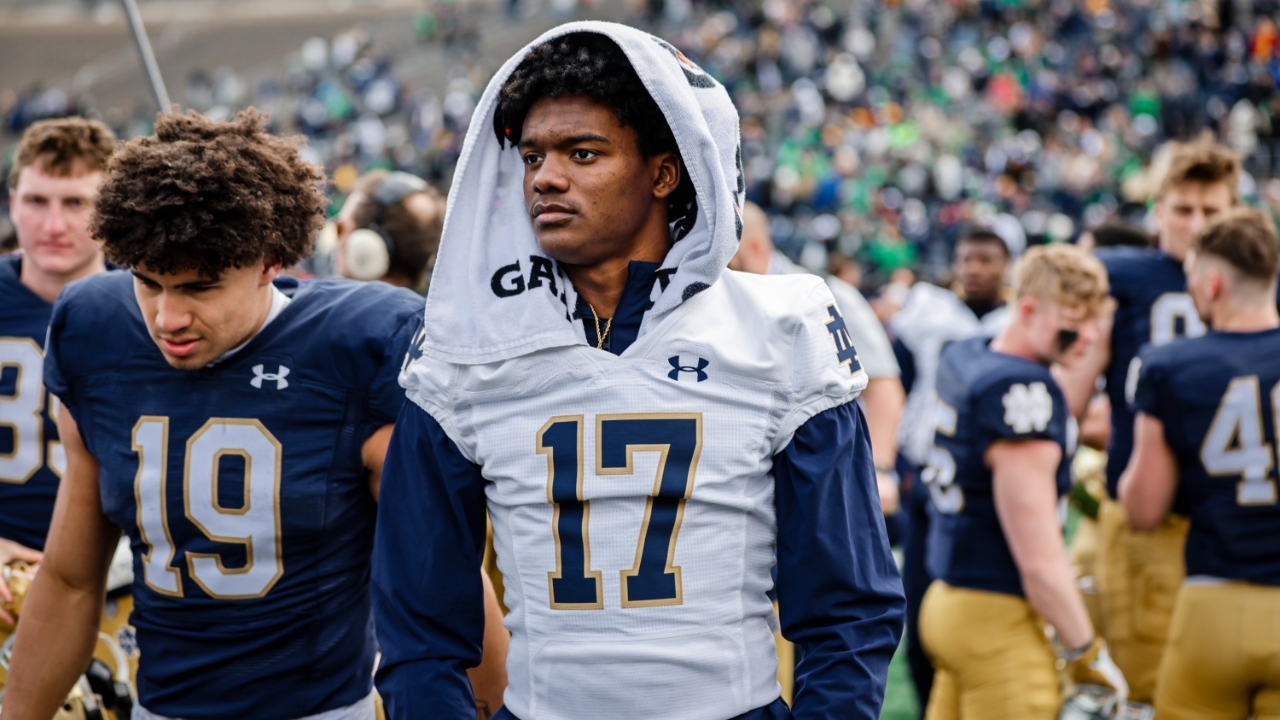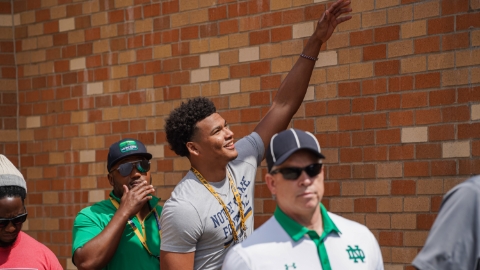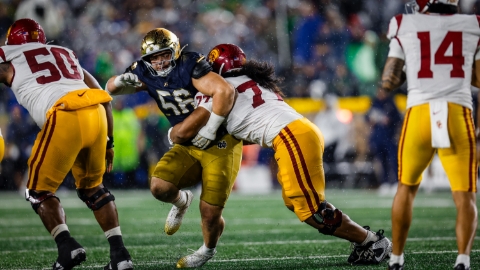
To win a national championship in today’s college football, having at least one elite receiver is a requirement. There hasn’t been a single champion in the College Football Playoff era who didn’t have a receiver drafted on day one or day two (first three rounds) of the NFL Draft.
Most champions had more than one. Georgia had six(!) receivers or tight ends from their 2021 team who ended up as high draft picks. Having an explosive passing game matters and it’s practically impossible to be an explosive offense without top tier talent at receiver.
This has been an obvious weakness for Notre Dame teams for most of the last decade. Will Fuller was the best deep threat in the country in 2015 before becoming a first round pick the next spring. They didn’t have another receiver drafted in the first three rounds until Miles Boykin in 2019. Chase Claypool followed that up as a second round pick the next year, but Notre Dame has only had one receiver drafted since then: Ben Skowronek went in the seventh round.
No one wins championships these days without having one of the best offenses in the country. The last six CFP winners all finished in the top-six in OF+ (combined FEI and SP+ ranking on offense). It’s close to impossible to be that good on offense without better talent at receiver.
16 of them were taken in the most recent draft and none of them were composite 5-stars. 11 of the 16 (68.8%) were blue-chips (4 or 5-stars). Only five were ranked in the top-100 and 11 of them were ranked outside of the top-200 (with one being a converted quarterback).
This isn’t a one year anomaly in terms of blue-chips ending up being drafted high. So yes, stars matter. Signing a “high 4-star” isn’t as important as many might believe it to be, though. The talent gap between a lot of these receivers isn’t that big and there are other factors that are important.
The film always comes first, but elite athletic markers are extremely important at the position. There are very few prospects like Jaden Greathouse who are playing top competition where being dominant against some of the best athletes in a state like Texas is more than enough to know he checks all of the proper boxes as an athlete.
In the last five NFL Drafts, there have been 78 receivers selected in the first three rounds. Not all of them have publicly available 40 times, short shuttle times, or recorded vertical jumps, but around 60% of them do. There’s a lot that can be learned from that testing in addition to track and field results and other notable athletic achievements.
Explosiveness is critical
Vertical is an important athletic test for just about every position and I highlighted the importance of it for projected edge rushers last week.
48 of the 78 receivers had recorded vertical leaps and the average for that group was 35.1 inches. There were no receivers with a vertical under 29 inches and only two under 30.
If a receiver recruit has a verified vertical under 29 inches as a rising senior, it’s safe to say there is very little chance they are going to develop into a high NFL Draft pick at the position. Claypool and Boykin were both bigger receivers and had verticals of 32.8 and 35.2 inches respectively. Fuller was drafted before this group of 78, but his vertical was 33.9 inches.
Short area quickness is huge
They test the short shuttle for a reason. It’s a great measure of short area quickness and change of direction ability. They don’t have recorded 3-cone times for many these players, but that is also a good way to measure those two traits.
45 of the 78 had recorded short shuttle times and the average time was 4.28. 36 (90%) had a short shuttle time of 4.50 or lower.
I wouldn’t call it a cross off if someone had a time higher than 4.5 because that would eliminate big body receivers like Claypool (4.53), USC receiver Drake London (4.53), or Ohio State’s Marvin Harrison Jr. (4.52), but if I’m looking at a smaller stature option in the slot, I want to see a low number here.
Alabama’s DeVonta Smith was and is rail thin, but his 4.13 short shuttle highlighted how quick he was out of his breaks. Purdue’s Rondale Moore (4.01), Louisville’s Tutu Atwell (4.01), and Michigan’s Roman Wilson (3.96) were never players who could win with size, but their short area quickness was a major reason why they were playmakers in college.
40 times are overrated
When it’s NFL Combine time and these players are now men who have spent years in college strength and conditioning programs in addition to working with trainers after they enter the draft, then a good 40 time is going to be important. If someone runs a blazing 40 times while they are in high school, that’s also a very good thing.
When Tennessee’s Jalin Hyatt ran a 4.31 and Alabama’s Henry Ruggs ran a 4.45 when they were recruits, it’s the kind of thing that should get everyone’s attention in a good way.
However, there have been too many big time receivers in college football who didn’t have anywhere close to blazing 40 times. 47 of the 78 had available 40 times and the average time was 4.56. 18 players ran 4.60 or slower and that list includes Claypool, Harrison Jr., Malik Nabers, Jaxon Smith-Njigba, George Pickens, Chris Olave, Garrett Wilson, Ja’marr Chase, Tee Higgins, CeeDee Lamb, and Justin Jefferson.
There’s a lot of top of the board receivers on that list I just mentioned. Every single one of them would be players that fall into the category of “Man, I wish we had that guy” for every college football fan in the country.
Smith-Njigba only ran a 4.64 40, but his short shuttle time (4.01) and vert (34.4) were outstanding. Olave and Wilson, also stars at Ohio State along with Smith-Njigba, ran 4.73 and 4.61 40s, but they had great short shuttle times (4.19 and 4.2) and verts (34.5 and 34.9).
Chase and Jefferson were probably the best one-two punch at receiver in the modern era of college football on that loaded 2019 LSU team. It was a 4.66 for Chase and a 4.88 for Jefferson in the 40. It was a 4.09 and 4.3 short shuttle for the two with 36.2 and 34.4 on the vert.
One of Notre Dame receivers coach Mike Brown’s former pupils at Cincinnati, Alec Pierce, ran a 4.65 40 in high school, but his short shuttle was 4.21 and his vertical was 38.1.
USC’s Amon-ra St. Brown wasn’t drafted in the first three rounds, but should have been. He was first team All-Pro last season. He ran a 4.67 40 in high school, but he also recorded a 4.2 short shuttle and 38.2 inch vertical. He definitely “has that dog in him” as a player, but he shouldn’t be sold short as an athlete.
BYU’s Puka Nacu is another receiver who wasn’t a high pick, but balled out as a rookie for the LA Rams. His 4.57 40 wasn’t poor, but a 4.36 short shuttle and 35.8 inch vert were better athletic indicators for him as a player.
Fuller ran a 4.53 in high school and I think everyone was surprised by just how fast he was at Notre Dame. He played much faster than that and ran a 4.32 at the NFL Combine.
The lesson is obvious. Don’t get caught focusing on a high school receiver not running a fast 40.
Track results and multi-sport stardom
29 of 78 (37.2%) had elite 100 or 200 meter times or recorded an elite long jump distance. There were two more who recorded an elite triple jump or high jump number. There’s a number of them who didn’t go to a major combine and put up testing numbers there, but they proved their athleticism with track results.
Shoutout again to The Athletic’s Dane Brugler and his scouting reports on all of these players because he not only lists track results for many of them, but he also has plenty of background on them as multi-sport athletes.
It should come as no surprise that many of these receivers also played basketball in high school and a dozen of them did much more than just play. Claypool, USC’s Drake London, Stanford’s Michael Wilson, Western Kentucky’s Malachi Corley, Florida State’s Keon Coleman, Purdue’s David Bell, Kentucky’s Lynn Bowden, and Minnesota’s Rashod Bateman were also studs on the basketball court.
The young receivers on Notre Dame’s roster have some encouraging track results and multi-sport backgrounds. Freshman Logan Saldate was elite in the long jump in high school and so was Cam Williams in addition to posting standout 100 and 200m times.
Everyone knows that Jordan Faison was and is a big time lacrosse player, but I don’t know if people are aware that Greathouse averaged 13.8 points per game in basketball or that Micah Gilbert averaged 15.5. Jordan’s brother, 2026 commit Dylan Faison, is also a great lacrosse player.
Notre Dame’s most recent 2025 wide receiver JonAnthony Hall is a very good basketball player in addition to posting an elite long jump number. Every Irish fan who follows recruiting closely is very aware that top of the board 2025 receiver target Derek Meadows has elite results in the 200 as well as the 110 and 300m hurdles.
2025 commit Elijah Burress ran a 4.68 40 at a camp last year, but it was the 30.1 inch vert and 6.99 second 3-cone time that stood out to me. He ran a 4.28 shuttle at camp this year as well. While he still needs a lot of physical development, that short area quickness shows up on film and it’s why I believe he’s underrated as a prospect.
2025 target Dylan Robinson is a legit 6-3 and the 4.49 40 that he ran this spring should not be ignored, especially because he hits the threshold with his short shuttle (4.31) and vertical (30.1).
Running the 100 in under 11 seconds or jumping like you’re floating on air doesn’t guarantee success for receivers. If it did, then this guy would have been a first round pick rather than an undrafted free agent.
And there will always be exceptions who don’t test well at camps for various reasons. Maliks Nabers had a 4.62 short shuttle and 29 inch vertical, which doesn’t exactly scream future top-10 pick. He was a faster, more explosive athlete in pads, though. He proved that at LSU and then tested like an elite athlete at their pro day.
College coaches and personnel people are still going to want as much verified testing information as possible. The two most important traits to look for with receivers are explosiveness and short area quickness. There’s plenty of data out there that backs it up.
Men's Champion Heathered Gray Notre Dame Fighting Irish Team Vault Logo Reverse Weave Pullover Hoodie



